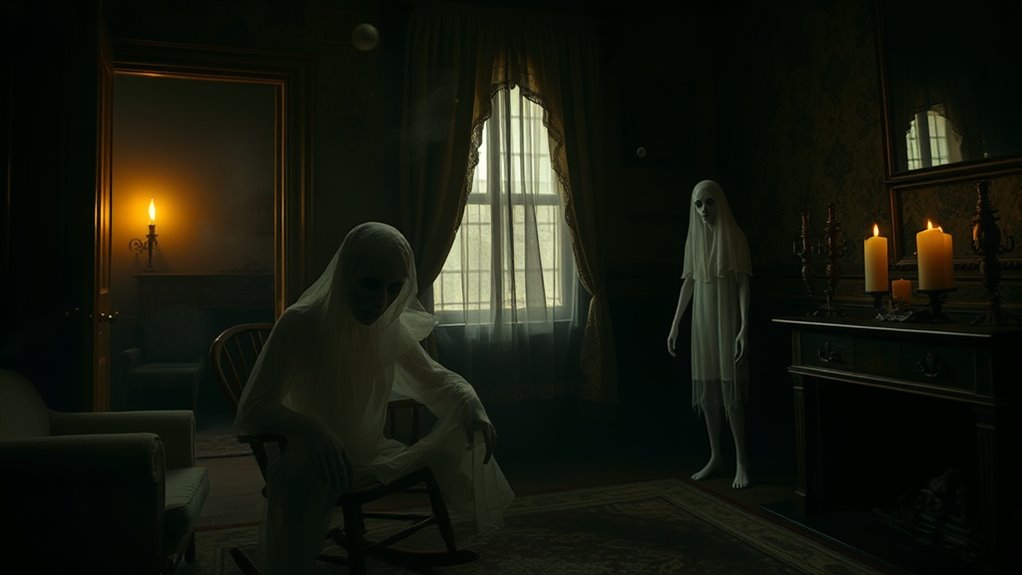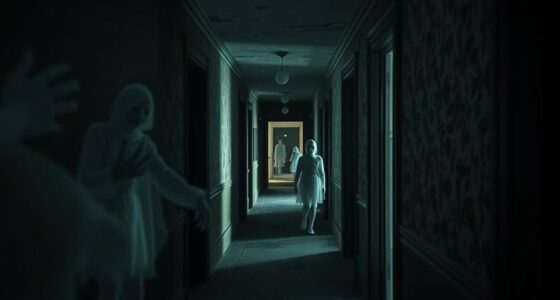There are mainly two types of hauntings you might encounter. Residual hauntings are like impassive recordings of past events, repeating routines without interaction, often linked to emotional memories linked to tragic locations. Poltergeist activity involves energetic disturbances like loud noises, moving objects, or physical effects caused by subconscious energy or external forces. Knowing these differences can help you understand what might be happening around you and get more insight into the mysterious phenomena—continue exploring to uncover the details.
Key Takeaways
- Residual hauntings are repeatable, passive impressions of past events, resembling a ghostly recording without active interaction.
- Poltergeist activity involves energetic, unpredictable disturbances like loud noises, moving objects, and physical disruptions.
- Active hauntings feature conscious spirits that communicate, manifest visibly, or respond to questions.
- The main differences include activity level, intent, and interaction, with residuals being passive and poltergeists more dynamic.
- Recognizing these distinctions helps in understanding, investigating, and addressing different haunted phenomena.

Have you ever wondered why some places feel haunted while others don’t? The truth is, the type of haunting you experience can vary greatly depending on the spirit activity involved. One common form is poltergeist activity, which is characterized by loud noises, moving objects, and sometimes even physical disturbances. Unlike traditional hauntings, poltergeists are often linked to energetic outbursts from living individuals rather than spirits of the deceased. These disturbances tend to occur suddenly and can escalate quickly, leaving witnesses feeling frightened and bewildered. The cause of poltergeist activity remains debated; some believe it’s rooted in subconscious energy, while others see it as an external supernatural force. Whatever the cause, it’s clear that poltergeist phenomena are active, dynamic, and often unpredictable, making them a fascinating but unsettling type of haunting.
In contrast, residual hauntings are quite different. Imagine a tape recording of a past event replayed over and over again—residual hauntings are similar. They are not the spirits of the dead actively interacting with the living but rather the lingering echoes of a significant moment in the location’s history. These hauntings are like emotional or energetic imprints that get embedded in the environment and replay periodically, often at specific times or under certain conditions. You might see a ghostly figure performing a routine task or hear footsteps in an empty hallway, but there’s usually no awareness or interaction from these apparitions. Residual hauntings tend to be harmless, predictable, and more like ghostly recordings than active spirits. They don’t respond to questions or attempts to communicate and are often associated with locations marked by tragedy or significant events.
Understanding the difference between poltergeist activity and residual hauntings is key to grasping the broader spectrum of paranormal phenomena. Poltergeist activity is energetic and sometimes aggressive, involving physical disturbances and emotional upheaval. Residual hauntings, however, are passive and repetitive, like a ghostly playback of history. While both can make a place feel undeniably haunted, they evoke very different reactions. Some might find the energetic chaos of a poltergeist thrilling, even terrifying, while others might be more intrigued by the quiet, mysterious presence of residual hauntings. Regardless of which type you encounter, knowing the distinctions helps you better interpret the strange experiences and understand the stories behind haunted locations.
Additionally, understanding the different causes of hauntings can help in developing appropriate responses or investigations, especially when considering reliable tools and methods.
Frequently Asked Questions
Can Hauntings Be Scientifically Proven?
Hauntings can’t be scientifically proven yet because paranormal research lacks conclusive evidence, making scientific skepticism common. You might experience strange phenomena, but without rigorous, repeatable experiments, these sightings remain unverified. While many believe in spirits or residual energies, science requires measurable proof. Until researchers develop reliable methods, hauntings stay in the domain of personal experience and speculation rather than confirmed fact.
Do All Haunted Locations Have Negative Spirits?
Not all haunted locations have negative spirits; many are filled with positive energies that bring comfort or inspiration. While some places might be haunted by negative spirits, others can simply be sites where positive energies linger, creating a welcoming atmosphere. It’s essential to keep an open mind and consider the energy you sense—whether it’s negative spirits or positive energies—since not every haunting involves negativity.
How Do I Differentiate Between a Ghost and a Spirit?
You can tell a ghost from a spirit by observing their behavior. For example, a residual haunting feels like a recording replay—constant and unchanging—while an intelligent haunting involves a conscious entity that interacts with you. Residual hauntings are energetic, like a looped event, whereas spirits are more like apparitional entities with awareness. Recognizing these differences helps you understand whether you’re dealing with a persistent energy or a conscious spirit.
Are Certain Times More Likely for Hauntings to Occur?
Yes, certain times are more likely for hauntings. You’ll notice timing patterns and seasonal fluctuations that increase the chances. For example, around holidays like Halloween, paranormal activity tends to spike due to heightened emotional energy and cultural focus on spirits. Additionally, certain lunar phases and specific times of day, like midnight, are believed to be more active for hauntings, making these periods prime for paranormal encounters.
Can Hauntings Affect Physical Health or Well-Being?
You might find that hauntings can impact your physical health and well-being. For example, a person experiencing repeated unexplained sensations might develop anxiety or sleep disturbances. These psychological effects can lead to physical symptoms like headaches, fatigue, or nausea. If you’re sensitive to such phenomena, the stress and fear caused by a haunting could weaken your immune system, making you more vulnerable to illness.
Conclusion
Now that you’ve explored the different types of hauntings—residual, poltergeist, and intelligent—you see how each one has its own story to tell. Recognize the subtlety in residual echoes, the chaos in poltergeist activity, and the awareness in intelligent spirits. Embrace the mystery, respect the unknown, and remain curious. Because whether you believe or not, the world of hauntings invites you to question, to wonder, and to keep searching for the stories that linger beyond the veil.









